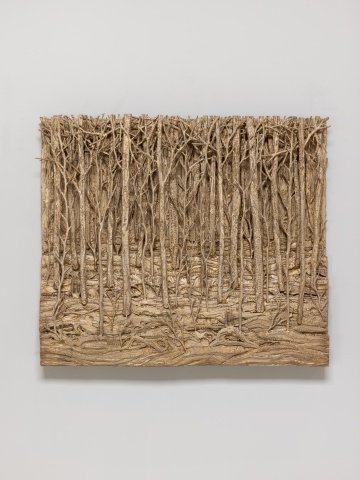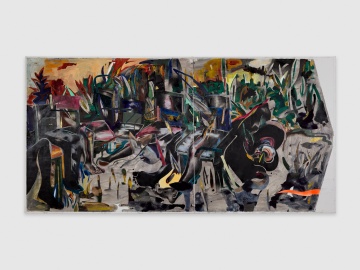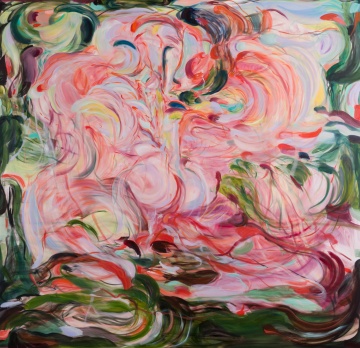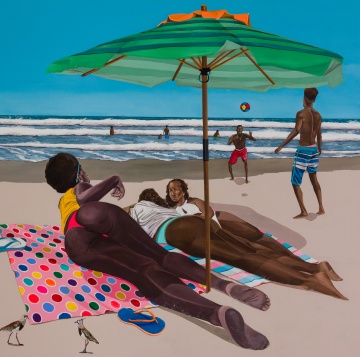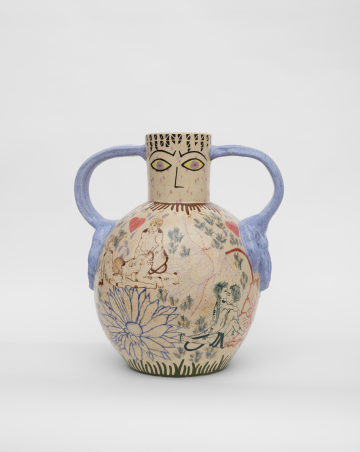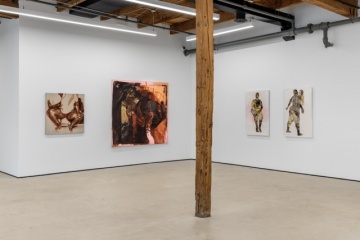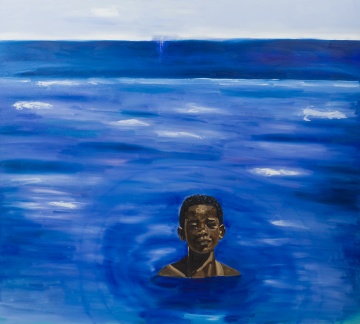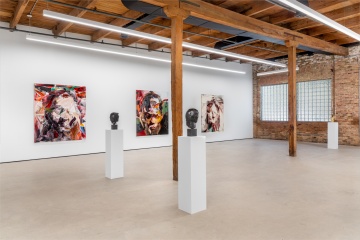Mariane Ibrahim Gallery
437 North Paulina Street
Chicago, IL 60622
312 877 5436
Chicago, IL 60622
312 877 5436
After founding her namesake gallery in Seattle, Ibrahim and her program oficially launched their space in Chicago in 2019. In September 2021, the gallery opened it's inaugural European space in Paris. In January 2022, the gallery will celebrate it’s 10 year anniversary.
Mariane Ibrahim has hosted acclaimed exhibitions from leading and emerging artists including Amoako Boafo, Clotilde Jimenez, Maimouna Guerresi, Ayana V. Jackson, and most recently Jerrell Gibbs.
The gallery has had an international presence at art fairs with prize-winning presentations.
Artists Represented:
ruby onyinyechi amanze
ruby onyinyechi amanze
Raphaël Barontini
Amoako Boafo
Florine Démosthène
Maïmouna Guerresi
Mwangi Hutter
Yukimasa Ida
Ayana V. Jackson
Clotilde Jiménez
Eva Jospin
Shannon T. Lewis
No Martins
Ian Mwesiga
Carmen Neely
Lorraine O'Grady
Zohra Opoku
Peter Uka
Works Available By:
ruby onyinyechi amanze
ruby onyinyechi amanze
Raphaël Barontini
Amoako Boafo
Florine Démosthène
Maïmouna Guerresi
Miranda Forrester
Mwangi Hutter
Yukimasa Ida
Ayana V. Jackson
Clotilde Jiménez
Eva Jospin
Shannon T. Lewis
No Martins
Ian Mwesiga
Carmen Neely
Lorraine O'Grady
Zohra Opoku
Peter Uka
Mwangi Hutter
You Begin to See the Signs
March 4, 2025 - April 16, 2025
Mariane Ibrahim is pleased to announce the upcoming exhibition in Chicago by artist duo Mwangi Hutter, entitled You Begin to See the Signs. The show will be on view from March 4 to April 16, 2025, and will mark the artists' third solo exhibition with the gallery and first in Chicago.
The exhibition will be on view in tandem with the group exhibition Project a Black Planet: The Art and Culture of Panafrica at the Art Institute Chicago, which includes Static Drift (2001), part of the museum's permanent collection.
Eva Jospin
Vanishing Points
November 15, 2024 - January 25, 2025
In an age of rapid advancement in virtual and augmented reality, Eva Jospin roots her practice in questioning perspective itself. In her tridimensional sculptures and immersive installations, she activates the illusion of depth to shift direct perception and guide the eye to multiple dimensions within each artwork— transforming sight into a conscious, interiorized process. As she explains, “I try to address the landscape as one we are part of—when nature becomes not just a space we observe but one we are inside of, it transforms into an interior, imagined vision.”
While the notion of linear perspective was first theorized in the 15th century by Leon Battista Alberti, Jospin’s practice expands this singularity. In Vanishing Points the artist underscores the impossibility of engaging in her work from a single viewpoint. This is formally evidenced in sculptural scenes that unveil their complexity when observed from varying angles, heights, and distances. Each work conjures a sense of immersion that evokes the presence and immediacy of a rich landscape that has not been flattened by representation. Enlivened through one’s imagination, the work is further heightened as an internal experience.
Inspired by the inhabitable structures of Italian Baroque gardens, Eva Jospin explores the ambiguity and theatricality of 18th century eccentric and decorative constructions found in parks also known as architectural follies. These forms bridge the visualities of a natural landscape to the curiosity and wonders evoked by sentimental and ornamental structures. Jospin works in their legacy as she blends the precision of architectural design with the fluidity of organic forms.
The artist’s technical explorations into embroidery and textiles embody a diversity that deepens the tactile experience between her bi-dimensional and three-dimensional artworks. This metamorphosis of material using bronze, silk threads, and cardboard, is a journey through landscapes where subtle details invite a shift in perspective. Through her integration of diverse materials, Eva Jospin navigates the spatial interrelationships between humanity, architecture, and nature in deep contemplation of their interconnectedness.
Vanishing Points is a chapter in the artist’s ongoing inquiry into the observer’s connection to their natural and built environment—a dialogue with resonance to the architectural heritage of Chicago, making this exhibition a fitting debut in the city.
Leasho Johnson
Escaping the tyranny of meaning
August 30, 2024 - October 26, 2024
Mariane Ibrahim is pleased to present Escaping the tyranny of meaning, a solo exhibition of new work by Leasho Johnson, on view from August 30 until October 26, 2024. This exhibition marks the artist’s first show with the gallery.
In reflection of the rich sociologies of Jamaica, the centrality of mythology in Leasho Johnson’s work acknowledges the Caribbean and diasporic heritage to solidify history through folklore and imagination. Johnson’s practice situates imagination as an incubator for uninhibited connection and self-expression. Navigating the complexities of dark, abstract realms, his practice reveals sudden bursts of figuration, where creatures of presence emerge with striking clarity. By blending and experimenting with drawing and painting techniques, Johnson creates lush, vivid images brimming with sensual intensity.
Image: Leasho Johnson, The centipede under two skies (Anansi #27), 2023. Courtesy of the artist and Mariane Ibrahim.
ruby onyinyechi amanze McArthur Binion Bethany Collins Carmen Neely Zohra Opoku Michael Rakowitz Edra Soto
Palimpsest
July 30, 2024 - August 24, 2024
Mariane Ibrahim is pleased to announce Palimpsest, a summer group exhibition presenting work by Bethany Collins, McArthur Binion, Carmen Neely, Zohra Opoku, ruby onyinyechi amanze, Michael Rakowitz, and Edra Soto. Palimpsest sparks dialogue between hegemonic and emergent histories, private and public iconographies, mythologies, and fantasies. The show will be on view from July 30 through August 24, 2024.
This convergence of work examines how drawing, painting, and sculpture serve as palimpsests as each embodies records of personal and diasporic narratives. These artworks highlight the opacity of history in our lives, where memories are veiled and known only through their traces. Composed of contested memories, social minutia and phenomena, alongside notions of spirituality and myth these visual records illustrate that even in the haste of erasure, histories may be shrouded, but traces remain, destined to be rediscovered.
Palimpsest illuminates the dynamic interplay between visibility and concealment, memory, and imagination in our lives. By engaging in detailed observation, viewers uncover how these interconnected residual histories shape personal and collective narratives.
Sol Kordich
Coming back to the one
May 29, 2024 - July 6, 2024
Sol Kordich (b. Buenos Aires, 1995) is an artist based in Berlin whose compositions exude sophistication and elegance, marked by a meticulous layering that imbues the canvas with depth and luminosity.
Within the intricate layers of color lie fragments of poetry, song lyrics, and notation, echoing the unseen yet profound aspects of human experience. This hidden complexity serves as a testament to the artist's belief in the significance of both the visible and the unseen.
Miranda Forrester
Interiorities
February 2, 2024 - April 3, 2024
As her figures waver between figuration and abstraction throughout her work in Interiorities Miranda Forrester paints instability at the edge of presence and disappearance.
Joël Andrianomearisoa, Alexandre Gourçon, Mwangi Hutter, and Tony Lewis
Almost here, Almost there, Almost home | Curated by Jérôme Sans
November 11, 2023 - January 20, 2024
Mariane Ibrahim is pleased to announce a group exhibition curated by Jérôme Sans, "Almost here, Almost there, Almost home," presenting work by Joël Andrianomearisoa, Alexandre Gourçon, Mwangi Hutter, and Tony Lewis, whose vocabularies converge on a minimalist aesthetic to explores complex emotions.
With an economy of means and color, the artists reflect upon the nature of dualities and emotion as they search for alignment amongst opposition. As fluid conversations on identity lead us to question the truth, use, and confines of labels, these works call into question the relevance of categorizing, alluding to humanity’s innate tendency to divide and classify in order effort to make sense of the world.
No Martins
Encontros Políticos (Political Encounters)…Part 2
September 15, 2023 - October 28, 2023
No Martins’ newest body of work confronts Brazil’s aspirational thesis of racial democracy. Through a series of nine large scale canvases, Martins depicts dark skinned Black people of varying genders, body types, friend groups, and familial dynamics in varying states of repose and interaction. Their gaze is turned towards each other, the ocean, or whatever thing they’re focused on - but never towards the viewer. Intentionally, Martins’ figures have no concern for anyone but themselves and the experience of sun, salt, and sea. In this manner, Martins gifts the Black people in his paintings an agency that is not recognized by the broader Brazilian society.
Nadira Husain, Zizipho Poswa, Jennifer Rochlin, Leena Similu, and Shafei Xia
Terra Recognita: A Ceramic Story
July 15, 2023 - August 26, 2023
Ceramics—despite being one of the world’s oldest art forms—have been discovered and rediscovered time and time again and with the work of these five artists, the medium is once again being challenged in both form and function. Terra Recognita refers to the idea of exploring charted territories and discovering new lands. The exhibition displays a broad stroke of diverse cultures and ceramic practices through the works of the exhibiting artists. As vessels, each of the works’ complexities of the present, past, and future highlight the artists and their individual cultures.
Carmen Neely
Sometimes a painting is a prayer
May 26, 2023 - July 8, 2023
Mariane Ibrahim is pleased to announce the inaugural solo exhibition with Carmen Neely entitled, Sometimes a painting is a prayer. On view from May 26 through July 8, the show is shaped through interwoven dimensions of intimacy, generosity, and risk, with Neely presenting her largest scale painting to date in conversation with lithographic prints of her personal journal pages and several works on paper.
A sharp line in dark plum traverses from the edge of the canvas and cuts through a melding of glazing brushstrokes. The emotional release of catharsis is often accompanied by an acute self-awareness, in its wake the hope of relief. Amidst this intense expulsion of feelings is a longing to regain some semblance of control. It is a part of healing. It is a part of living in a world that demands productivity while too often overlooking holistic wellbeing. It is soul work and as Bambara’s quote advises, it is difficult to hold. Carmen Neely’s paintings grapple with these interior landscapes, generating visual languages of sensuous gestures and decisive lines, while integrating asemic writing with legible text.

Patrick Eugène
50 LBS
April 12, 2023 - May 20, 2023
50 LBS marks Patrick Eugène’s inaugural solo exhibition in Chicago, and in celebration of his new artist representation by the gallery. With just fifty pounds of luggage, one is meant to journey with the entirety of their life. What about those migrating in hopes for a better future? The exhibition will explore how Haitian families, escaping the oppressive conditions during the dictatorships of François "Papa Doc" and his son, Jean-Claude "Baby Doc", navigated this difficult passage as they attempted to improve their circumstances during NYC's immigration boom in the 1960s-70s.
Okiki Akinfe, ruby onyinyechi amanze, M. Florine Démosthène, Miranda Forrester, Taiye Idahor, Shannon T. Lewis, Olukemi Lijadu, Temitayo Ogunbiyi
HAUNTOLOGY: GHOSTLY MATTERS
January 27, 2023 - April 1, 2023
“Black experience in any modern city or town in the Americas is a haunting. One enters a room and history follows; one enters a room and history precedes.”
- DIONNE BRAND, A Map to the Door of No Return
Mariane Ibrahim is pleased to announce Hauntology: Ghostly Matters, a group exhibition curated by Nigerian-British curator, Aindrea Emelife. The show is on view in Chicago from January 27 - April 1, 2023, featuring work by Okikioluwa Akinfe, ruby onyinyechi amanze, M. Florine Démosthène, Miranda Forrester, Taiye Idahor, Shannon T. Lewis, Olukemi Lijadu and Temitayo Ogunbiyi.
Coined by Jacques Derrida in his 1993 book Specters of Marx, Hauntology is used to describe a sense in which contemporary culture is quite literally haunted by the “lost futures” of modernity. Emelife positions this perspective alongside the African concept of Ubuntu, in which our sense of self is shaped by our relationships with others, creating a way of living that begins with the translation and resulting premise, “I am” only because “we are." With this, the exhibition explores the ideas of Black womanhood - the soul, the body, the mind - and seeks to find healing and restoration, promoting oneness rather than fragmentation by uniting the many perspectives of female artists from Africa and the diaspora.
The work of Olukemi Lijadu emphasizes the concept of African anthropology and how that relates to personhood and the body in a holistic sense. One of the crossover themes explores how Black womanhood is also embedded in an intricate network of relationships with family (living and dead), the community, God and nature. This view is the antithesis of Greek and the later Cartesian view with its dualistic split between body and soul. The film explores the artist’s relationship with religion, informed by her grandmother, a study of African philosophy, and her Catholic upbringing which come together to represent the fragments of her identity.
Avery F. Gordon’s book Ghostly Matters talks about the haunting of history peeking through, in which she writes, “haunting is not the same as being exploited, traumatized, or oppressed, although it usually involves these experiences or is produced by them.” Instead, Gordon argues, haunting is a kind of “animated state in which a repressed or unresolved social violence is making itself known.”
The past and the present are not discrete categories, like dead and alive, planes on top of planes. Collage speaks to this construction, as embodied by Shannon T. Lewis whose assemblage painting style fragments the form to whimsical effect, but it is in the pursuit of freedom; freedom from stereotype, archetype and marginalization. They are free in their multiplicity, as are Okikioluwa Akinfe’s bodies, which retreat and confront from within blurred lines between figuration and abstraction. With lyrical fluidity, Akinfe interrogates social body language and how race and cultural upbringing enhances or weakens archetypes applied to Black women.
Temitayo Ogunbiyi envisions how parts of the body, her own and other bodies of color, can come together to create new compositions that consider community, environment, interdependence, and spirituality. Looking principally to forms found in nature, and how they can be emulated by human gestures such as hairstyling, the work brings together tradition and nature. Inspired by Yoruba adages, the work imbues the idea that every living being has a spirit.
Similarly, Taiye Idahor’s focus on hair as a motif symbolizes ancestral connections, family, lineage and history. Unraveling the complexities of identity, her work employs a surrealistic style embedded with symbols that reflect tradition and memory.
M. Florine Démosthène exists between dream and nightmare, possibility and actually, as she explores the Black female body as a myriad of collective experiences beyond immediate interpretations based on sensuality. Whereas Miranda Forrester’s exploration of the queer Black female gaze also serves to address the invisibility of women of color in art history.
The show also nods to Toni Morrison’s Sula, which imagines Black women dreaming as one, imagining possible and impossible futures. ruby onyinyechi amanze forms a world that imagines boundless futures for Black women. Celebrating the oneness of ubuntu, the weightlessness of the work negotiates away from the heaviness of linear time, understanding the contemporary mythologies and the futuristic feeling of now.
“Positioned squarely in a fixed liminality, the show explores spaces of hybridity that Black women exist in. As Black women, we are haunted by expectations, historical and cultural stereotypes, that are fixed principally on our bodies and how they exist and have existed in the world. These artists create as protection, to explore and create the possibilities of the future and new memories of the past. It is survival. Haunting is not negative, it is a profound invention.” - Aindrea Emelife
Maïmouna Guerresi
The Fall: Awa and Adama
November 5, 2022 - December 23, 2022
Mariane Ibrahim is pleased to announce the solo exhibition of Italian-Senegalese artist Maïmouna Guerresi, entitled The Fall: Awa and Adama. The exhibition will be on view in Chicago from November 5 – December 23, 2022.
In Maïmouna Guerresi's works the viewer is nudged toward a metaphysical realm; A suspended reality, balanced between the breath of the human and the divine, where time has yet to originate. In this atemporal place light is extinguished with the fall of the human, setting the stage for the primigenial subjects Guerresi exquisitely portrays. The characters are sculptural figures, literally and figuratively, that recount the original myth, shared by the three Abrahamic faiths, Judaism, Christianity, and Islam, through their poses and gestures.
Ian Mwesiga
Theaters of Dreams
September 17, 2022 - October 29, 2022
Mwesiga’s works are abjectly peaceful scenes that appear simple in their composition but upon close observation subtly suggest questions whose responses only engender more questions. His subjects are always either dressed in blue or positioned against a blue background. Where a piano is included, the subject is either standing on it, leaning over it, or looking past it. The piano becomes a kind of anchor, it keeps time, it props up its subjects, but also allows them to experience rest. It is an instrument that provides multiple experiences none of which are about its primary use — music making.
In color psychology, blue is understood as a calming color that brings peace and serenity. It is also a color, particularly in its association with water that hides the depths beneath. When associated with ice or the sky it can give rise to feelings of distance. Mwesiga’s blues imply and depict action. They are reflective of a young man’s dreams of playing basketball and the distinctive movements of his body while playing.
Image Caption:
Ian Mwesiga, Basketball Player IV, 2022. Courtesy of Mariane Ibrahim
Zohra Opoku
I Have Arisen...
April 8, 2022 - May 14, 2022
The Myths of Eternal Life is Zohra Opoku’s latest body of work—an art practice that sought to be both healing and transformative. I Have Arisen will unveil Part One of this series, the second to debut in her first solo exhibition in Paris.
Across Zohra Opoku’s practice, one might consider an underlying question: How do we hold it all together when things are fragmented or have fallen to pieces? Opoku answers this by making evident her sutures. Her new series continues to ponder this inquiry, as she brings together two years of works that she created in the wake of her cancer diagnosis to stitch together a story of devastation and rejuvenation.
ruby onyinyechi amanze, Raphaël Barontini, Amoako Boafo, M. Florine Démosthène, Jerrell Gibbs, Maïmouna Guerresi, Mwangi Hutter, Yukimasa Ida, Ayana V. Jackson, Clotilde Jiménez, Shannon T. Lewis, Sergio Lucena, No Martins, Ian Mwesiga, Ferrari Sheppard, Zohra Opoku and Peter Uka
La Vie en Rose
February 5, 2022 - March 19, 2022
In using flowers as a subject, the artists present each bespoke work as a congratulatory gesture while exploring historical meanings and personal relevance of the efflorescence. Of the many artistic, historical, and emotional meanings and symbols of flowers, La Vie en Rose contemplates the beauty of and the idea of coming back to life.
“In our 10th year, I envisioned flowers to present a resistance and a reclamation of beauty and joy in this new departure. They symbolize the purity and passion, the flowers from the artists are an offering, an antidote, a hopeful reminder of the fragility of life. The result is breathtaking, a collection of flower arrangements reflecting the artist own signature,” states Mariane Ibrahim.
Peter Uka
Longing
November 13, 2021 - December 18, 2021
Mariane Ibrahim is pleased to announce Longing, the gallery's inaugural exhibition with Peter Uka. On view in Chicago from November 13 – December 18, 2021, the show marks the artist's first show with the gallery and in the United States.
Novelist Zadie Smith commented that “historical nostalgia” was a sentiment not “available” to black people: “I can’t go back to the fifties because life in the fifties for me is not pretty, nor is it pretty in 1320 or 1460 or 1580 or 1820 or even 1960 in this country, very frankly.”
The large-scale oil paintings exude notions of nostalgia, a gaze on spaces long forgotten. The works timeless ability arise from a query, how do we document a history that was unwritten, and only told orally? Of historical memories recounted and not crystallized.
Moments in time are captured, each representing a chamber of reflection, all solely painted from memory. Uka finds strength in referencing familiar scenes and moments in Nigeria, through an era specific and recognizable collective memory. These instants were engraved in his early recollections – poses of brothers arm in arm, the bright, surrounding colors and patterns – presenting his personal link to his life left behind when moving to Germany. His works form a tangible way to display mutuality in the experience worldwide, an affirmation of presence.
Throughout the 20th century, African Americans conceived various radical political paradigms to redefine their social positions and assert their humanity. Uka references these theories to show their commonplace, but also heightens relevant stylistic patterns and color to outline the beauty in their wistfulness. Uka moves beyond portraiture and examines fleeting gestures, where multiple figures appear in public spaces, away from their individualized interior environments.
The patterns and backgrounds inspired by 70s wallpapers embellish the new settings, a nod to his previous works which similarly draw upon elements of clothing, dance and posture. The 70’s, although still alive in the memory of many, may be too far gone to have any relevance on the outlook and identities of people today, however they function to deviate from the conversation surrounding art and history which remain largely centered on authenticity, oppression, and pain.
The stimulus of Uka’s practice comes from what he deems "the quantum leap", his necessary footstep into the unknown. These moments of nostalgia facilitate the continuity of identity, further persisting in his future work. The paintings showcase a nostalgia for life that is colorful and full of bliss. There continues to be space and yearning for joy, reflection, and redefinition.
Jerrell Gibbs
Sounds of Color: Recorded Memories
September 4, 2021 - October 22, 2021
Gibbs avails the new body of work as a point of departure to explore musicality in his compositions. As harmony is the basis of color theory and melody emulate the unity of color, the dynamic and symphony are defined through Gibb’s pictorial touch. Paying homage to the Impressionists, the paintings are vivid in pointillism, the oscillating contours of his paintings meld the skin tone and monochrome backgrounds into a modern sfumato.
The boy in all of the works represents a multitude of voices, ideas and ways of living. For the artist, the color, the ‘people of color’ portray the multiple and myriad of experiences and ideas that should be painted about, explored and shown. There is a continuation of gesture which acts as a thread between each work.
Repetition is a constant throughout the paintings, resemblances are disposed in order to discover particularities of a memory. The recurrence of stroke join the colors with the repeated figure, as the artist uses repetition as a form of distinction. Visual and palette rhythms, cannot be replaced, echoing a secret vibration which animates profoundness.
The fictional portraits mark a shift from his interest in acquainting the past, and instead reflect a pursuit of redefining representations. Figurative compositions explore contemporary identity to “change the narrative rather than repeat the renegade.” Gibbs attention lies in manifesting a youthful and revitalized future defined by schisms of contemporary Black solace.
Although no musical collaboration will accompany the paintings, Gibbs challenges himself to communicate the rhythmic energy present in his subjects and their environment. By implementing concepts of synesthesia, playing with textures and utilizing a bright selection of color, the vibrancy of the image protrudes from the canvas, awakening the gallery into a space of spontaneous leisure.
Sounds of Color: Recorded Memories is his repartee, from exploring the legacies inherited through his family for generations, to how he attempts to define his own legacy and his own genre in art history.
Yukimasa Ida
Here and Now
June 26, 2021 - August 14, 2021
Mariane Ibrahim is pleased to announce the upcoming solo exhibition of Japanese artist Yukimasa Ida, entitled “Here and Now” on view, in Chicago, from June 26 – August 14, 2021. The show marks the artists debut in the United States.
In the new body of work for “Here and Now”, Ida is focused on life and death as an eternal cycle and includes distorted portraits and bronze sculptures of human heads. Ida continues to experiment with spontaneous as well as intentional patterns. Each of his works merge various intensities of stroke, communicating specific ranges of emotion. Every piece embodies a snapshot of a memory, reflecting the way the human mind processes a fleeting moment…construed and inconsistent.
ruby onyinyechi amanze
Thinghood
May 7, 2021 - June 5, 2021
The show will be on view from May 7 – June 5, 2021 and will present seven new drawings. To make these works, over twenty-five different drawings were created, then cut and systematically reassembled into their finished form.
amanze is currently working with a newly reduced capsule of seven recurring elements that include: swimming pools, ada and audre - who masquerade as swimmers/divers, dancers and pseudo lovers - windows and other architectural references, okada [motorcycle taxis], pigeons in flight and the paper itself. amanze speaks lovingly of each of the elements as individual forms. Now having isolated them from their former cohort, they take on new meaning as the ones that stayed. Human-like beings and inanimate objects ultimately share the same function; flat forms that interact and move [play] in endless configurations to create a multi-dimensional and therefore, illogical space.
amanze’s drawings are an illusion; a suggestion of an expansive unnamed world situated between nowhere and everywhere. Primarily using graphite, fluorescent inks and photo transfers, each layer of space within the drawing has, with calculation and spontaneity, been negotiated, constructed and ultimately invented.
To build upon the layering of space within the drawing, amanze has begun to explore a process of creating a final work that consists of overlapping multiple sheets of paper. Taking this one step further and embracing the puzzle-like element of parts within a whole, the drawings In Thinghood come together towards the end of the process. amanze removed any semblance of knowing in advance what the works would be and opened an organic dialogue with the drawings about what they could become. With almost thirty separate units to compose with, there are virtually infinite possibilities to bend planes and disrupt logic.
Sergio Lucena
The Blue that embraces me...
March 12, 2021 - April 10, 2021
The Blue that embraces me...highlights the silent essence that illuminates the memory of such things that, individually and intimately, bring us back to ourselves. These seminal landscapes seek to identify the contours of life, presenting a kind of tracing of the soul as the artist views his work as a spiritual language, a way to see life as a sacred experience of interrelations.
The show marks a defining moment in the artists career as Lucena’s artistic production is moving toward a wider understanding of “limit” as a concept. The limit being both the environs that define a space and those naturally perceived. As a painter, Lucena felt the need to run against the limits of language. The duplicity of these slivers of light is the boundary that invites us to extend beyond the previously established liminal environments and spatial interstices to expand our point of view and create a new and unanticipated permeance.
Raphaël Barontini
The Night of the Purple Moon
January 30, 2021 - March 6, 2021
The Night of the Purple Moon, marks the gallery’s inaugural presentation with the artist and his first solo gallery show in the United States.
The gallery will be transformed into a Galerie des Illustres, an otherworldly environment with large scale portraits on canvas, cloaks, chaps and flags. Fictional heroes and historical reinterpretations embellish subjects from classical and canonical histories: from the Caribbean, Voodoo and magical deities, to function as a way for formerly enslaved humans to hold on to their African identity, despite the violence of Western colonialism. Barontini illuminates disparities in the visual and cultural history of the French Caribbean, which is rooted in African ancestry, yet virtually saturated with culture of an insular Caribbean.

 Back to all Member Galleries
Back to all Member Galleries

